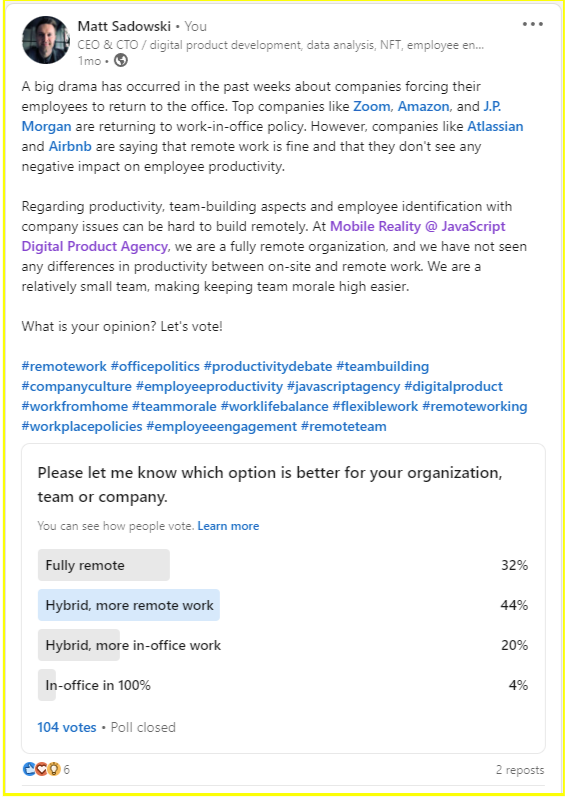Introduction
As we enter the fifth year of remote work’s popularity, it’s clear that 2020 marked a turning point. Initially, even skeptical employers embraced remote work, giving employees access to numerous 100% remote positions.
Now, at the end of 2024, some companies, like Zoom, Amazon, J.P. Morgan, and Elon Musk's ventures, are shifting policies, requiring employees to return to the office or end their contracts. However, companies like Dropbox, Gitlab, Medium, and Mobile Reality remain fully remote and have no plans to change.
For perspective, Mobile Reality CEO Matt Sadowski recently ran a LinkedIn poll asking followers about their preferred work style. With 104 votes, "hybrid work" was the most popular choice, followed by "remote work from home," while only 4% opted for "100% in-office work." See the poll results below for a full comparison.

So what is the truth?
Everyone wants to be one of the remote workers and working from home, and yet companies return to 100% work in-person? After a few years of consideration, what's the future of work can we finally say which option is best for your company? Maybe a hybrid work model?
To answer this question, let's analyze remote work and in-office work in more detail and find the winner of the battle: working at home vs in-office. Let’s find out the differences and pros and cons.
Fully remote work pros and cons
1. Flexibility and autonomy
Remote work offers unmatched flexibility for employees and employers, as there's no need to work from a single location or adhere to rigid hours. You can attend a midday appointment, make up the time later, or live outside the city while serving clients worldwide. In contrast, office work requires set hours and location, limiting such adaptability. Remote employees can work whenever they are most productive, whether it’s at night or on weekends, as long as they deliver results. This level of flexibility simply isn’t feasible in a traditional office setup, where employees must be present at specific times and locations.
2. Savings on commuting and work attire
Commuting costs disappear entirely with 100% remote work, saving both employees and employers money on fuel, parking, and even commute and delivery options—unless, of course, you’re driving daily for a Matcha latte! Remote work also lets you live anywhere, even in a sunny spot like Los Angeles, without the added expenses. Beyond cost, remote work saves valuable time. A one-hour commute each way amounts to 10 hours a week—essentially an entire workday that could be spent with family or on meaningful projects. And while some may use commute time to learn, it's challenging to focus or work effectively, especially in a crowded environment or while driving.
3. Personal life and job satisfaction
While commuting time has already been discussed, remote work undoubtedly enhances work-life balance. Although some argue that remote work can blur the boundaries between professional and personal life, leading to longer hours or multitasking, many remote workers excel at managing their schedules. Remote work allows people to travel, spend time with family, or take short breaks during the day without compromising productivity. Unlike the office, where breaks are limited, remote work offers the freedom to pause for a nap, walk the dog, or play with kids, as long as the work gets done. This flexibility fosters a better work-life balance and often a greater sense of well-being.
4. Productivity and performance
Productivity in remote versus in-office work varies, as employees have unique rhythms and peak times for creativity and focus. Some excel at 5 a.m., while others are most productive after 5 p.m. Remote work enhances productivity and job satisfaction by allowing employees to work during their optimal hours without the disruptions common in an office. For instance, in an office setting, back-to-back meetings often leave little time for focused tasks, pushing essential work into personal hours and diminishing work-life balance.
Although not all in-office roles operate in constant meeting mode, unexpected interruptions can still impact productivity, which is less of an issue in a remote environment where employees have more control over their schedules.
5. Cost savings being at home
This probably doesn’t need much explanation. As a business owner, you save on costs for office spaces, kitchen supplies, furniture, cleaning, electricity, and even things like maintaining the office coffee machine. For remote workers, "home stats" reveal savings on commuting, work-specific meals, and professional outfits. However, keep in mind that remote employees may appreciate an allowance to help cover internet, electricity, or other home office expenses, as they bear these costs. Regardless of allowances, both sides benefit financially from remote work.
Another benefit is the reduction in "office politics." Remote work minimizes in-person interactions that can lead to gossip or conflicts over trivial issues, creating a more focused and less politically charged environment.
6. Recruitment's main difference
When working remotely, the whole world opens up for your recruitment process. You don't have to look for a candidate only in the area where your company and his home are located. You can invite someone from the other side of the world to cooperate with you, who will have skills that you might not find in your city. As we can read at www.cnbc.com:
“Employers enjoy higher employee retention and can recruit from a broader pool of applicants, said Julia Pollak, chief economist at ZipRecruiter. They can save money on office space, by recruiting from lower-cost areas of the country or by raising wages at a slower pace due to workers’ perceived value of the work-at-home benefit, she said.”
Additionally, as I mentioned at the very beginning, remote work is currently the preferred form chosen by candidates. Remember, however, that in the case of employees in different time zones, there may be delays in communication, which may affect the remote employee productivity and efficiency of the tasks while working remotely.
Are you looking for trusted software agency for software developement or data science project?

7. Communication and collaboration challenges
Remote work enables diverse teams to exchange knowledge and experiences, boosting productivity and growth. Remote teams often develop a strong sense of responsibility and independence when management provides trust, whereas excessive oversight can reduce motivation.
Possible disadvantages of remote work include challenges with team integration; without regular in-person interaction, employees may feel disconnected. Regular virtual meetings for both work updates and personal connections, along with remote-friendly integration events, help strengthen bonds, enhancing collaboration and productivity.
8. Mental and physical health
This point raises mixed feelings. Many enjoy using commute time for personal activities, like training or taking a few minutes to unwind at home after a tough client meeting. However, others feel isolated in remote work, with less physical activity and social interaction, which can lead to feelings of loneliness and even depression, affecting their work quality. Here, the office holds a clear advantage—humans are social beings who thrive on connection.
For remote teams, it’s essential to support by encouraging participation in sports, wellness workshops, or group activities for all employees. Prioritizing health is key.
9. Isolation and lack of communication
Communication in a remote team differs significantly from in-office interactions and often faces more challenges. Written communication can lead to misunderstandings, delayed responses, and even conflicts, especially with team members in different time zones. Delays of up to 12 hours can create stress, frustration, and lowered productivity.
Person work pros include the immediacy and clarity of in-person communication, which often reduces misunderstandings and allows for quicker resolution of questions. To minimize remote communication issues, consider implementing mandatory daily check-ins where the team can discuss their tasks and progress. Establishing a communication strategy, such as a response time policy within 2–4 hours, can also help. Tailor your approach to best support your company and team members.
10. Less Spontaneity, possible disadvantages
There is no spontaneity in home office work. You have to accept it. No one will surprise you with a birthday cake. No one will surprise you in the kitchen. You won't spontaneously approach anyone to discuss a case. When writing to someone remotely, you cannot expect that person to respond immediately. If you want to talk to someone longer, you need to make an appointment with that person. When working remotely, there are few spontaneous opportunities for team integration. Everything must be organized, otherwise, your work and communication will not move forward.
11. Knowledge and career growth
It's tough to pick a clear winner in the work-from-home vs. office debate. While in-office teams have the advantage of easily sharing information by simply asking colleagues directly, this often relies on informal “know-how.” Remote work, however, typically requires documentation in databases, streamlining onboarding, and preventing interruptions when someone is on vacation or leaves the team.
12. Control over a work environment
While remote work may seem free of control, oversight still occurs, sometimes excessively. Some companies require employees to stay on video for hours or use apps that track mouse movement. Each company has its own approach, but remote work ultimately relies on trust. While tracking progress is reasonable, excessive micromanagement—whether remote or in-office—benefits no one.
13. Technical issues with reliable technology in remote work
Unfortunately, when working remotely, everyone has to deal with all technical or equipment problems on their own. Unlike in an office, you can’t just take a flooded laptop to the help desk and have it replaced within an hour. Instead, you need to send the equipment and wait for a replacement. Remote work can also come with distractions and home responsibilities, from household tasks to family interruptions, which can further complicate focusing on work tasks. Access to certain resources may require connecting via a remote desktop or waiting for authorization, and resolving technical issues remotely often takes extra time.
14. Employee engagement
While remote work might appear to lack engagement, companies often invest extra effort into monitoring and boosting it, addressing key remote work challenges. Remote employees are frequently recognized, with many companies implementing automated systems for praise, like add-ons to Slack or Microsoft Teams, such as NFT Reality, which allow for quick kudos and help strengthen employee commitment.


Advantages and disadvantages of office work
1. Commuting and work
A traditional office work schedule involves commuting and work attire costs, which remote workers avoid. Even if employees use commuting time for personal enrichment, they still have less time for their private lives than remote workers. To support office-based employees, consider arranging shared transportation for those living nearby or helping them connect with colleagues in the same area. Many may not realize a teammate lives just a few streets away, enabling a carpool option that saves money and time.
2. Potential for distractions and difficulty with work
In an office, teams have more daily interactions, fostering stronger bonds, especially within a traditional day work week. However, this doesn’t always enhance effectiveness and can lead to difficulty with work focus. In-office employees can be easily distracted by casual chats and unrelated activities, sometimes even sparking conflicts over trivial matters. While team interactions are valuable, do they need to happen daily for quality and productivity?
3. Collaborative environment and in-person work
In office work, communication is undoubtedly much faster, people are more responsive because it is easier to talk to someone sitting at the desk next to you. It's easier to walk up to someone, ask them a question, and then go back to your place. However, this has one significant drawback. What? Such that communication in-person/in-office work is more chaotic. People don't have to wonder whether it makes sense to bother someone. They just do it. Sometimes asking questions without context upset the other party because this topic has already been discussed many times.
When working remotely, communication is more difficult and slower, but often more organized. When writing to someone, we write to present the full context of the message and check whether we have written about such things before.
4. Opportunities for mentorship and employee growth
Discipline in offices often feels forced, with employees working or appearing productive under managerial watch. When managers are absent, productivity may drop, showing that imposed discipline can’t replace genuine engagement. This isn’t about location but about trust. Managers often keep less trusted employees in-office, signaling that self-motivation isn’t expected.
While some employees need oversight, consider if you want a team that lacks intrinsic motivation. Remote work, by contrast, often enhances productivity through trust and accountability, with employees motivated by independence and responsibility.
5. Flexibility in work hours and work schedule

There is little flexibility in office work for both employers and employees. You are all limited by the work hours of your office or factory. To do your job, you have to be in a specific place. You may even give some people occasional remote work, but I assume that these people still have to work during everyone else's working hours. Is it bad not to have this flexibility? It's up to you to think about what you're missing out on because of this. Maybe it's because young employees are not interested in such work, which is why your team lacks a fresh perspective.
6. Recruitment: Home vs Office
When recruiting for an in-office job, you must be aware that you will face many limitations. The job ad will only reach people who are from your area or are looking for a job in your region. Candidates who have great skills and who are on the other side of the country will not even see your job offer and will not apply for it. Also remember that someone, even from your city, who would be perfect for this position, but who has been working remotely since 2020 and prefers this type of work, will not want to change it. So once again you lose the opportunity to hire a good person. By offering work 100% in-office, you will lose the opportunity to increase your pool of candidates, thus selecting truly the best ones.
7. Customizable workspace for productivity and job satisfaction
Cons of office work include the potential downsides of close monitoring and the potential for office politics. While oversight allows managers to observe employees’ activities, constant monitoring can demotivate, especially those who feel their autonomy is restricted. Talented employees may even leave due to a lack of trust. Although managers need some level of control, offering remote or hybrid options can foster trust and boost motivation. If employees don’t respond well, you can always reassess—but providing flexibility is worth exploring for its positive impact on commitment and reducing office politics.
8. Work life balance
Research and new studies show that work-life balance can be impacted both positively and negatively by remote and office work. While remote work and flexible schedules may support a healthier balance for some, others may find it challenging. Ultimately, it depends on the individual and how they organize their tasks. However, research shows that work-life balance often suffers more in traditional office roles with fixed hours, largely due to the added time and stress of commuting.
9. Control of productivity and work
Cons of office work include the potential downsides of close monitoring and the potential for office politics. While oversight allows managers to observe employees’ activities, constant monitoring can demotivate, especially those who feel their autonomy is restricted. Talented employees may even leave due to a lack of trust. Although managers need some level of control, offering remote or hybrid options can foster trust and boost motivation. If employees don’t respond well, you can always reassess—but providing flexibility is worth exploring for its positive impact on commitment and reducing office politics.
10. Home stats: time and expenses considerations
Costs… there are costs in working in an office workspace, and yes, there are a lot of them. Employees commuting, office rent, bills, coffee in the kitchen, chairs, desks, materials, “Fruit Thursdays”, etc. You can implement savings plans, and you can try to reduce costs, but you know, when comparing working at home vs office, working in the office will always generate higher costs than working remotely or hybrid.
Are you ready to start the app development process and boost your startup?

11. Spontaneous interactions: Pros of Office
The main difference is that the office environment offers more spontaneity. A birthday might bring everyone together for cake, or a quick chat in the company kitchen can lift spirits. Colleagues can decide last minute to go out after work, which isn’t feasible with remote teams spread across different locations. For remote workers, even meeting once a year may not always be possible.
12. Professional growth benefits
In-office work may make knowledge transfer seem easier, as employees can simply ask questions directly. However, this often results in unrecorded, disorganized information. If a knowledgeable person is absent, such as during a vacation, it can cause delays. Remote work, on the other hand, typically emphasizes building an organized knowledge base, enabling automated processes, and ensuring continuity even when someone is unavailable.
13. Collaboration and team building opportunities
It’s assumed that working in an office naturally fosters engagement, but this isn’t always the case. Despite the pros of office environments and the structured work environment they provide, work engagement can be low due to various factors: a manager's bad mood affecting the team, rumors circulating, or an employee feeling undervalued when others who underperform are favored. Additionally, in-office settings often lack formal opportunities for praise or recognition, which can further diminish engagement.
Conclusion
Now, which is better: remote or in-person work? After considering the pros and cons, it's clear that the choice between remote versus office work largely depends on your team, industry, and work style. However, as the Mobile Reality CEO's poll indicates, when given the choice, most people lean toward hybrid work. This model allows the benefits of a remote workforce and flexibility along with occasional in-person interactions, making it more appealing than fully in-office arrangements. Remember, if your team prefers remote options, they may seek those opportunities elsewhere if not available. Small adjustments, like occasional remote days or flexible shifts, can go a long way in keeping employees engaged. Adapt to changing market needs, and you’ll attract and retain top talent.
Do you see other pros or cons, or perhaps you've experienced communication and collaboration challenges? Or do you want to share your work from home tips for successful remote work? Let us know!
Insights from HR and EB in the IT industry
Are you curious about the unique challenges and innovative solutions in HR and employer branding within the IT industry? At Mobile Reality, we're excited to share with you a wealth of insights from our experiences. Discover the problems we face, the strategies that drive us, and the creative ideas we implement in our HR and employer branding initiatives. Dive into our collection of related articles featured on our blog – a treasure trove of knowledge awaits you:
Enjoy exploring these insights. Should you have any questions, don't hesitate to reach out to us. If you're interested in joining our dynamic team, explore the opportunities in our career section and submit your CV. We look forward to hearing from you!




